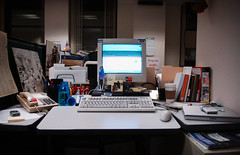"Is FeedJournal a threat to newspapers?" That's the most common question people ask when they first hear about FeedJournal. As I see it, FeedJournal is not a threat by itself, as much as the blogosphere it represents. Readers today have seen the light in the form of the blog; fresh thought-provoking content from their favorite writers are just a mouse-click away. They don't care if the writer is a journalist at NY Times or someone with a free Blogger account. What they do care about is that the content is niched, relevant and fresh. If the readers on top of that has the opportunity to interact with the article and its author by comments - so much the better.
 Blogging means different things for different people. One important, and significantly large, group of bloggers write regularly, and on topic. These are the writers who are willing to take on the new role of the independant journalist. The smaller the niche, the larger the chance of keeping your readers. With this, we have the long tail of journalism. Mainstream newspapers cannot possibly compete with that. For example, I subscribe to a blogger who writes about my home village in Sweden, interspersed with stories from my new home, Israel, where she used to live. A traditional newspaper cannot possibly compete with that. Another example is the wealth of feeds about online publishing - high quality content where new innovative ideas are discussed and put forth daily. A traditional newspaper cannot possibly compete with that.
Blogging means different things for different people. One important, and significantly large, group of bloggers write regularly, and on topic. These are the writers who are willing to take on the new role of the independant journalist. The smaller the niche, the larger the chance of keeping your readers. With this, we have the long tail of journalism. Mainstream newspapers cannot possibly compete with that. For example, I subscribe to a blogger who writes about my home village in Sweden, interspersed with stories from my new home, Israel, where she used to live. A traditional newspaper cannot possibly compete with that. Another example is the wealth of feeds about online publishing - high quality content where new innovative ideas are discussed and put forth daily. A traditional newspaper cannot possibly compete with that.
The future role of the traditional newspaper is about to change. These papers are continuing to cater to an average reader with average interests. By trying to tread this middleway, the newspapers are deperately trying to keep their reader base lukewarm, while the readers turns to blogs for the stuff they're passionate about. The only way newspapers can compete is by niching themselves. The prime example of this is the local newspaper, specializing in a smaller geographical region. These local newspapers have struggled lately as subscriptions have slumped, but by the single virtue of specialization they could very well be the heirs of tomorrow's dying newspaper industry.
The problem with being an individual journalist in the long tail of the blogosphere is that it is terribly difficult to make a living from it. Who will pay for the content being offered for free on the blog? Surely, online advertisements will not provide monetary benefits comparable to what the newspaper pays today. As the number of not-for-profit journalists/bloggers increases daily, the future looks more and more grim for the traditional journalist.
This post was inspired by yesterday's article "Journalism at the Crossroads: Change Or Die" by Scott Carp of Publishing 2.0. That post collects a nice set of links narrating the decline of the newsroom. Don't miss the zesty comments.
Comments
Post a Comment